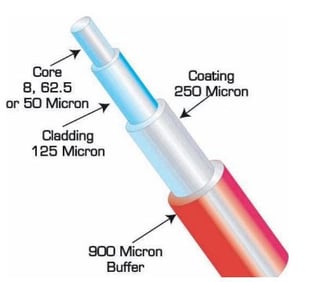This week we are looking to determine what factors need to be taken into consideration when choosing Fiber Optics Cables over low-voltage Copper Cables. There are so many benefits. Keep reading to find out more....
First things first... How does it work?

Fiber Optic Cable are composed of fine hair-like glass fibers and messages are transmitted by sending light beams down the thin strands of glass through a shielded cable. Fiber Optics Cables are comprised of three main areas:

1) Core: Designed as the light carrier of the optical fiber. It is made from a doped glass(Silica).The silica material of the core allows the light signals to be carried efficiently and effectively across the fiber.
2) Cladding: It is made up from a different type of silica and surrounds the core. The glass of the cladding is made to contain the light within the core.
3) Plastic Coating: This piece surrounds the Cladding and acts as a protector for the glass. It is normally clear (color), but for all Outdoor cables the coating is color coded to help identify the individual fibers. The coating has to be removed to connect the fiber to a connector or splice.
Advantages of Fiber Optic Cables:
Bandwidth
Investing in Fiber Optic Cables can significantly increase any businesses bandwidth compared to the transmission of data over the standard Copper Cable. The high frequency ranges they are able to carry exceed even the highest frequencies of any standard copper wire. Also, the speed of messages does not decrease as more demands are added onto the network when using Fiber Optics.
Security
Due to the higher demand for secure connections Fiber Optics Cables are a cost-effective way of adding an additional layer of security to any business. Copper Cables can easily be accessed by connecting taps to any line to pick up on the electronic signals, however, tapping Fiber Optics Cables is much more difficult.
Energy Efficient
The light waves that are transmitted through glass or plastic threads (fibers) use much less energy than data signals sent through metal conductors of Copper Cables.
Easy Installations/Testing
Fiber Optics Cables provide a light weight variation thus, makes terminating the cables more simplified. Also, testing a Fiber Optic Cable is as easy as sending a beam of light from one end to the other.
In order to make installations easier for Fiber Optics, West Penn Wire also provides cabling, installation kits, fiber optics assemblies, fiber optics cassettes and cable management solution.
Weight and Strength
Fiber Optic Cable is also designed to be much thinner and lighter with pull tensions being much greater than those of most Copper Cables.
For Example:
- 6-Fiber Cable: 300 lbs.
- RG6 Coaxial Cable: 55 lbs.
- Category 5E Cable: 25 lbs.
Variety of Applications:
Fiber Optics is also available for numerous applications, which are included but not limited to:
- Telecommunication
- High bandwidth Data
- Video signaling
- Long distance CCTV
- Communication between fire alarm panels
- and much more!
If you have questions about if Fiber Optic Cables are right for your organization, check out West Penn Wire Fiber Optics Cable Guide. We can help learn more about low voltage cable solutions that improve uptime, maintain security, and help improve user access email us at Sales@westpennwire.com or call 800-245-4964.
Did you find this post useful? Let us know in the comment section below!


